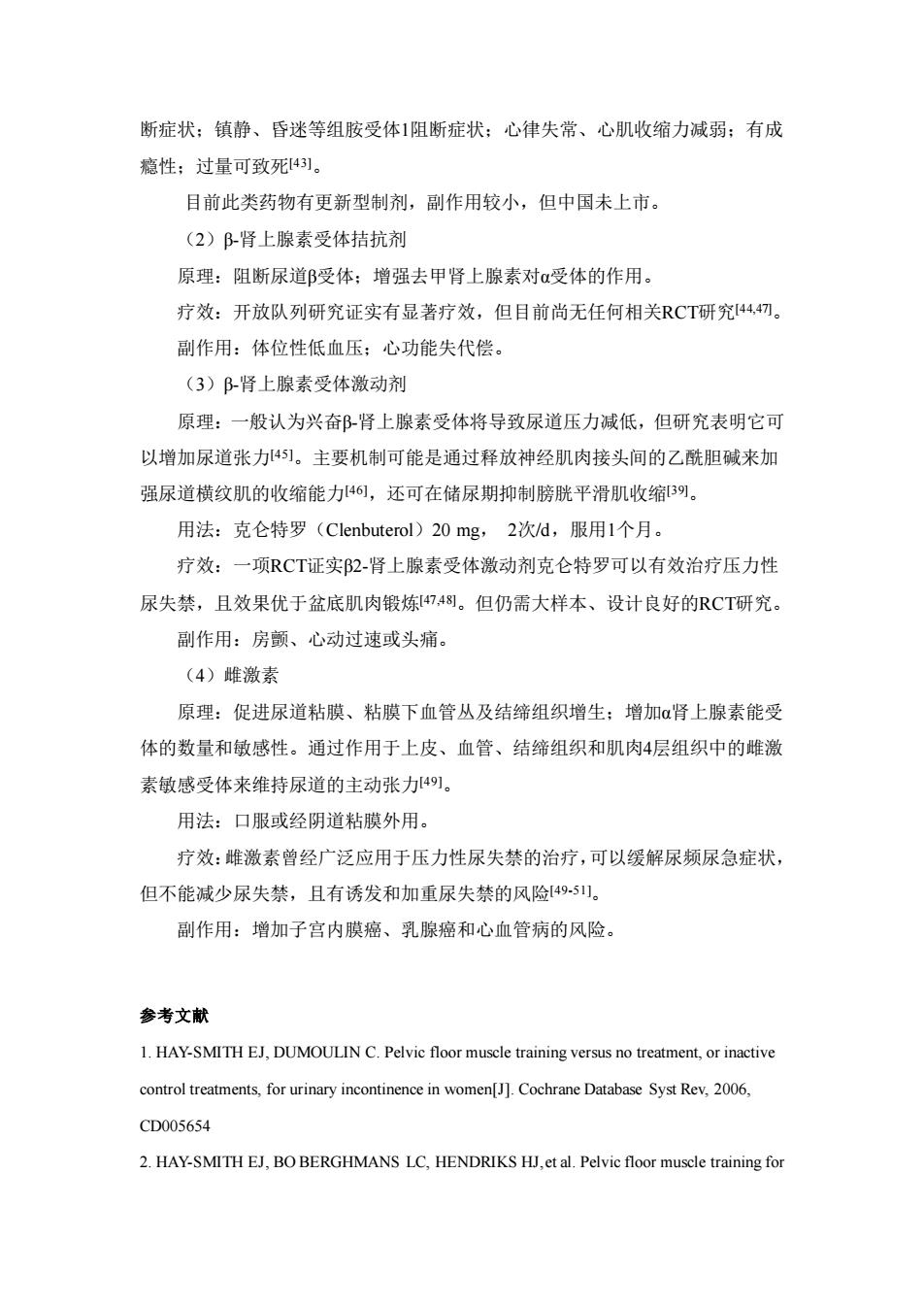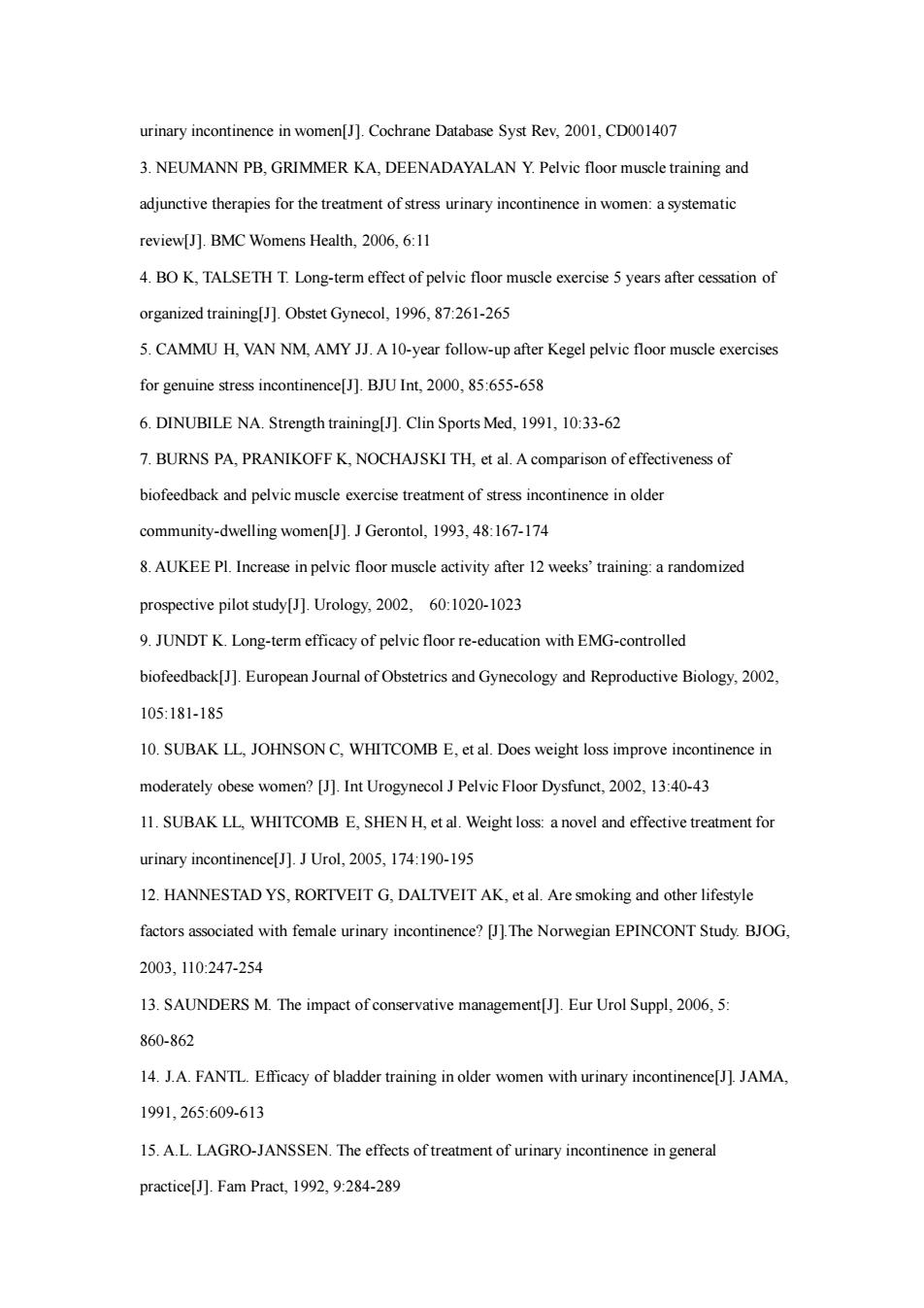
断症状:镇静、昏迷等组胺受体1阻断症状:心律失常、心肌收缩力减弱:有成 瘾性:过量可致死4。 目前此类药物有更新型制剂,副作用较小,但中国未上市。 (2)B肾上腺素受体拮抗剂 原理:阻断尿道邹受体:增强去甲肾上腺素对α受体的作用。 疗效:开放队列研究证实有显著疗效,但目前尚无任何相关RCT研究44,4切。 副作用:体位性低血压:心功能失代偿。 (3)阝肾上腺素受体激动剂 原理:一般认为兴奋B肾上腺素受体将导致尿道压力减低,但研究表明它可 以增加尿道张4)。主要机制可能是通过释放神经肌肉接头间的乙酰胆碱来加 强尿道横纹肌的收缩能力46,还可在储尿期抑制膀胱平滑肌收缩39。 用法:克仑特罗(Clenbuterol)20mg,2次/d,服用1个月。 疗效:一项RCT证实2-肾上腺素受体激动剂克仑特罗可以有效治疗压力性 尿失禁,且效果优于盆底肌肉锻炼47,4。但仍需大样本、设计良好的RCT研究 副作用:房颤、心动过速或头痛。 (4)雌激素 原理:促进尿道粘膜、粘膜下血管丛及结缔组织增生:增加α肾上腺素能受 体的数量和敏感性。通过作用于上皮、血管、结缔组织和肌肉4层组织中的雌激 素敏感受体来维持尿道的主动张41。 用法:口服或经阴道粘膜外用。 疗效:雌激素曾经广泛应用于压力性尿失禁的治疗,可以缓解尿频尿急症状, 但不能减少尿失禁,且有诱发和加重尿失禁的风险495。 副作用:增加子宫内膜癌、乳腺癌和心血管病的风险。 参考文献 1.HAY-SMITH EJ,DUMOULIN C.Pelvic floor muscle training versus no treatment,or inactive control treatments.for urinary incontinence in womenIJ].Cochrane Database Syst Rev.2006. CD005654 2.HAY-SMITH EJ,BO BERGHMANS LC,HENDRIKS HJ.et al.Pelvic floor muscle training for
断症状;镇静、昏迷等组胺受体1阻断症状;心律失常、心肌收缩力减弱;有成 瘾性;过量可致死[43]。 目前此类药物有更新型制剂,副作用较小,但中国未上市。 (2)β-肾上腺素受体拮抗剂 原理:阻断尿道β受体;增强去甲肾上腺素对α受体的作用。 疗效:开放队列研究证实有显著疗效,但目前尚无任何相关RCT研究[44,47]。 副作用:体位性低血压;心功能失代偿。 (3)β-肾上腺素受体激动剂 原理:一般认为兴奋β-肾上腺素受体将导致尿道压力减低,但研究表明它可 以增加尿道张力[45]。主要机制可能是通过释放神经肌肉接头间的乙酰胆碱来加 强尿道横纹肌的收缩能力[46],还可在储尿期抑制膀胱平滑肌收缩[39]。 用法:克仑特罗(Clenbuterol)20 mg, 2次/d,服用1个月。 疗效:一项RCT证实β2-肾上腺素受体激动剂克仑特罗可以有效治疗压力性 尿失禁,且效果优于盆底肌肉锻炼[47,48]。但仍需大样本、设计良好的RCT研究。 副作用:房颤、心动过速或头痛。 (4)雌激素 原理:促进尿道粘膜、粘膜下血管丛及结缔组织增生;增加α肾上腺素能受 体的数量和敏感性。通过作用于上皮、血管、结缔组织和肌肉4层组织中的雌激 素敏感受体来维持尿道的主动张力[49]。 用法:口服或经阴道粘膜外用。 疗效:雌激素曾经广泛应用于压力性尿失禁的治疗,可以缓解尿频尿急症状, 但不能减少尿失禁,且有诱发和加重尿失禁的风险[49-51]。 副作用:增加子宫内膜癌、乳腺癌和心血管病的风险。 参考文献 1. HAY-SMITH EJ, DUMOULIN C. Pelvic floor muscle training versus no treatment, or inactive control treatments, for urinary incontinence in women[J]. Cochrane Database Syst Rev, 2006, CD005654 2. HAY-SMITH EJ, BO BERGHMANS LC, HENDRIKS HJ,et al. Pelvic floor muscle training for

urinary incontinence in women[]Cochrane Database Syst Rev,2001.CD001407 3.NEUMANN PB,GRIMMER KA,DEENADAYALAN Y.Pelvic floor muscle training and adjunctive therapies for the treatment of stress urinary incontinence in women:a systematic review[].BMC Womens Health,2006.6:11 4.BO K,TALSETH T.Long-term effect of pelvic floor muscle exercise 5 years after cessation of organized training[J].Obstet Gynecol,1996,87:261-265 5.CAMMU H.VAN NM,AMY JJ.A10-year follow-up after Kegel pelvic floor muscle exercises for genuine stress incontinence[J].BJUInt,:655-658 6.DINUBILE NA.Strength training[J].Clin Sports Med,1991,10:33-62 7.BURNS PA.PRANIKOFFK.NOCHAJSKI TH,et al.Acomparison of effectiveness of biofeedback and pelvic community-dwelling women[].J Gerontol,1993,48:167-174 8.AUKEE PI.Increase in pelvic floor muscle activity after 12 weeks'training:a randomized prospective pilot study[J].Urology,:1020-1023 9.JUNDTK.Long-term efficacy of pelvic floor re-education with EMG-controlled biofeedback[European Joual of Obstetrics and Gynecology and Reproductive Biology,002 105:181-185 10.SUBAK LL JOHNSONC,WHITCOMB E,et al.Does weight loss improve incontinence in moderately obese women?[J].Int Urogynecol JPelvic Floor Dysfunct,002.13:40-43 11.SUBAK LL WHITCOMB E,SHEN H,etal.Weight loss:a novel and effective treatment for urinary incontinence[J].J Urol,005.174:19-195 12.HANNESTADYS,RORTVEIT G.DALTVEIT AK,etal.Are smoking and other lifestyle factors associated with female urinary incontinence?[]The Norwegian EPINCONT Study.BJOG. 2003,110247-254 13.SAUNDERS M.The impact of conservative management[J].Eur Urol Suppl,006,5: 860-862 14.J.A.FANTL.Efficacy of bladder training in older women with urinary incontinence[J]JAMA, 1991,265:609-613 15.A.L LAGRO-JANSSEN.The effects oftreatment of urinary incontinence in general practice[].Fam Pract,19929:284-289
urinary incontinence in women[J]. Cochrane Database Syst Rev, 2001, CD001407 3. NEUMANN PB, GRIMMER KA, DEENADAYALAN Y. Pelvic floor muscle training and adjunctive therapies for the treatment of stress urinary incontinence in women: a systematic review[J]. BMC Womens Health, 2006, 6:11 4. BO K, TALSETH T. Long-term effect of pelvic floor muscle exercise 5 years after cessation of organized training[J]. Obstet Gynecol, 1996, 87:261-265 5. CAMMU H, VAN NM, AMY JJ. A 10-year follow-up after Kegel pelvic floor muscle exercises for genuine stress incontinence[J]. BJU Int, 2000, 85:655-658 6. DINUBILE NA. Strength training[J]. Clin Sports Med, 1991, 10:33-62 7. BURNS PA, PRANIKOFF K, NOCHAJSKI TH, et al. A comparison of effectiveness of biofeedback and pelvic muscle exercise treatment of stress incontinence in older community-dwelling women[J]. J Gerontol, 1993, 48:167-174 8. AUKEE Pl. Increase in pelvic floor muscle activity after 12 weeks’ training: a randomized prospective pilot study[J]. Urology, 2002, 60:1020-1023 9. JUNDT K. Long-term efficacy of pelvic floor re-education with EMG-controlled biofeedback[J]. European Journal of Obstetrics and Gynecology and Reproductive Biology, 2002, 105:181-185 10. SUBAK LL, JOHNSON C, WHITCOMB E, et al. Does weight loss improve incontinence in moderately obese women? [J]. Int Urogynecol J Pelvic Floor Dysfunct, 2002, 13:40-43 11. SUBAK LL, WHITCOMB E, SHEN H, et al. Weight loss: a novel and effective treatment for urinary incontinence[J]. J Urol, 2005, 174:190-195 12. HANNESTAD YS, RORTVEIT G, DALTVEIT AK, et al. Are smoking and other lifestyle factors associated with female urinary incontinence? [J].The Norwegian EPINCONT Study. BJOG, 2003, 110:247-254 13. SAUNDERS M. The impact of conservative management[J]. Eur Urol Suppl, 2006, 5: 860-862 14. J.A. FANTL. Efficacy of bladder training in older women with urinary incontinence[J]. JAMA, 1991, 265:609-613 15. A.L. LAGRO-JANSSEN. The effects of treatment of urinary incontinence in general practice[J]. Fam Pract, 1992, 9:284-289